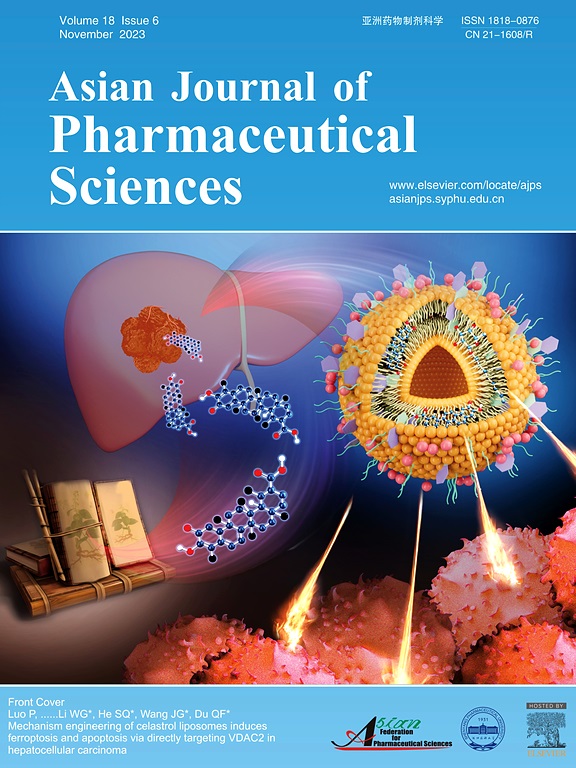Immune response recalibration using immune therapy and biomimetic nano-therapy against high-grade gliomas and brain metastases
IF 10.7
1区 医学
Q1 PHARMACOLOGY & PHARMACY
引用次数: 0
Abstract
Although with aggressive standards of care like surgical resection, chemotherapy, and radiation, high-grade gliomas (HGGs) and brain metastases (BM) treatment has remained challenging for more than two decades. However, technological advances in this field and immunotherapeutic strategies have revolutionized the treatment of HGGs and BM. Immunotherapies like immune checkpoint inhibitors, CAR-T targeting, oncolytic virus-based therapy, bispecific antibody treatment, and vaccination approaches, etc., are emerging as promising avenues offering new hope in refining patient's survival benefits. However, selective trafficking across the blood-brain barrier (BBB), immunosuppressive tumor microenvironment (TME), metabolic alteration, and tumor heterogeneity limit the therapeutic efficacy of immunotherapy for HGGs and BM. Furthermore, to address this concern, the NanoBioTechnology-based bioinspired delivery system has been gaining tremendous attention in recent years. With technological advances such as Trojan horse targeting and infusing/camouflaging nanoparticles surface with biological molecules/cells like immunocytes, erythrocytes, platelets, glioma cell lysate and/or integrating these strategies to get hybrid membrane for homotypic recognition. These biomimetic nanotherapy offers advantages over conventional nanoparticles, focusing on greater target specificity, increased circulation stability, higher active loading capacity, BBB permeability (inherent inflammatory chemotaxis of neutrophils), decreased immunogenicity, efficient metabolism-based combinatorial effects, and prevention of tumor recurrence by induction of immunological memory, etc. provide new age of improved immunotherapies outcomes against HGGs and BM. In this review, we emphasize on neuro-immunotherapy and the versatility of these biomimetic nano-delivery strategies for precise targeting of hard-to-treat and most lethal HGGs and BM. Moreover, the challenges impeding the clinical translatability of these approaches were addressed to unmet medical needs of brain cancers.

利用免疫疗法和仿生纳米疗法对高级别胶质瘤和脑转移瘤的免疫反应重新校准
尽管采用了手术切除、化疗和放疗等积极的治疗标准,但高级别胶质瘤(HGGs)和脑转移瘤(BM)的治疗在20多年来仍然具有挑战性。然而,该领域的技术进步和免疫治疗策略已经彻底改变了hgg和BM的治疗。免疫疗法,如免疫检查点抑制剂、CAR-T靶向、溶瘤病毒治疗、双特异性抗体治疗和疫苗接种方法等,正在成为有前途的途径,为改善患者的生存效益提供了新的希望。然而,选择性穿越血脑屏障(BBB)、免疫抑制肿瘤微环境(TME)、代谢改变和肿瘤异质性限制了免疫疗法对HGGs和BM的治疗效果。此外,为了解决这一问题,基于纳米生物技术的生物启发给药系统近年来受到了极大的关注。随着技术的进步,如特洛伊木马靶向和注入/伪装纳米颗粒表面的生物分子/细胞,如免疫细胞,红细胞,血小板,胶质瘤细胞裂解液和/或整合这些策略得到杂交膜进行同型识别。与传统纳米颗粒相比,这些仿生纳米疗法具有更大的靶向特异性、更高的循环稳定性、更高的活性负荷能力、血脑屏障通透性(中性粒细胞固有的炎症趋化性)、降低的免疫原性、高效的基于代谢的组合效应、以及通过诱导免疫记忆预防肿瘤复发等优势,为改善HGGs和BM的免疫治疗结果提供了新的时代。在这篇综述中,我们强调神经免疫疗法和这些仿生纳米递送策略的多功能性,以精确靶向难以治疗和最致命的hgg和BM。此外,针对脑癌未满足的医疗需求,解决了阻碍这些方法临床可翻译性的挑战。
本文章由计算机程序翻译,如有差异,请以英文原文为准。
求助全文
约1分钟内获得全文
求助全文
来源期刊

Asian Journal of Pharmaceutical Sciences
Pharmacology, Toxicology and Pharmaceutics-Pharmaceutical Science
CiteScore
18.30
自引率
2.90%
发文量
11
审稿时长
14 days
期刊介绍:
The Asian Journal of Pharmaceutical Sciences (AJPS) serves as the official journal of the Asian Federation for Pharmaceutical Sciences (AFPS). Recognized by the Science Citation Index Expanded (SCIE), AJPS offers a platform for the reporting of advancements, production methodologies, technologies, initiatives, and the practical application of scientific knowledge in the field of pharmaceutics. The journal covers a wide range of topics including but not limited to controlled drug release systems, drug targeting, physical pharmacy, pharmacodynamics, pharmacokinetics, pharmacogenomics, biopharmaceutics, drug and prodrug design, pharmaceutical analysis, drug stability, quality control, pharmaceutical engineering, and material sciences.
 求助内容:
求助内容: 应助结果提醒方式:
应助结果提醒方式:


